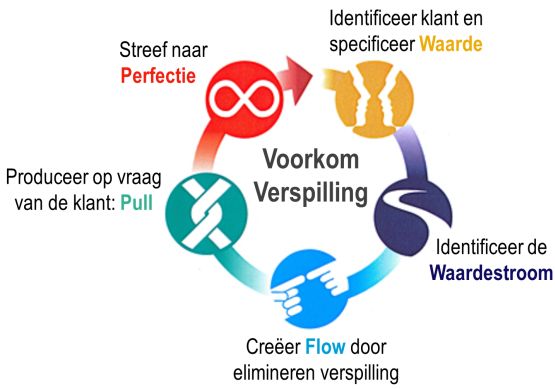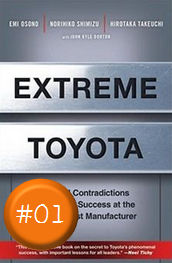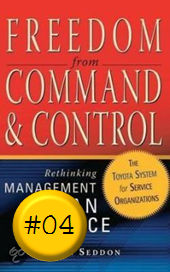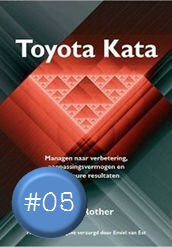James Womack en Daniel Jones beschrijven in hun boek Lean Thinking - Banish Waste and Create Wealth in Your Corporation de essentie van Lean door in te gaan op de denkwijze (bestaande uit vijf stappen) achter/van Lean:
![]()
Muda. It’s the one word of Japanese you really must know. It sounds awful as it rolls off your tongue and it should, because muda means 'waste', specifically any human activity which absorbs resources but creates no value: mistakes which require rectification, production of items no one wants so that inventories and remaindered goods pile up, processing steps which aren’t actually needed, movement of employees and transport of goods from one place to another without any purpose, groups of people in a downstream activity standing around waiting because an upstream activity has not delivered on time, and goods and services which don’t meet the needs of the customer.
Taiichi Ohno (1912–1990), the Toyota executive who was the most ferocious foe (woeste vijand, bs) of waste human history has produced, identified the first seven types of muda described above and we’ve added the final one. Perhaps there are even more. But however many varieties of muda there may be, it’s hard to dispute - from even the most casual observation of what gets done in an average day in the average organization - that muda is everywhere. What’s more, as you learn to see muda in the pages ahead, you will discover that there is even more around than you ever dreamed.
Fortunately, there is a powerful antidote to muda: lean thinking. It provides a way to specify value, line up value-creating actions in the best sequence, conduct these activities without interruption whenever someone requests them, and perform them more and more effectively. In short, lean thinking is lean because it provides a way to do more and more with less and less - less human effort, less equipment, less time, and less space - while coming closer and closer to providing customers with exactly what they want.
Lean thinking also provides a way to make work more satisfying by providing immediate feedback on efforts to convert muda into value. And, in striking contrast with the recent craze for process reengineering, it provides a way to create new work rather than simply destroying jobs in the name of efficiency.
(1) Specify Value
The critical starting point for lean thinking is value. Value can only be defined by the ultimate customer. And it’s only meaningful when expressed in terms of a specific product (a good or a service, and often both at once) which meets the customer’s needs at a specific price at a specific time.
Value is created by the producer. From the customer’s standpoint, this is why producers exist. Yet for a host of reasons value is very hard for producers to accurately define. (...) What only comes up when we push it to the foreground is the specific products the firm expects specific customers to purchase at a specific price to keep the company in business and how the performance and delivered quality of these products can be improved while their fundamental costs are pushed steadily down. In raising this issue it’s of ten revealing to ask these executives a simple question: Can you put yourself in the position of a design as it progresses from concept to launch, an order as information flows from initial request to delivered product, and the physical product as it progresses from raw material to the customer, and describe what will happen to you at each step along the way? Usually there is an awkward silence, and then, if we aren’t persistent, these issues quickly slip out of sight to be replaced once more by aggregated financial considerations. In short, the immediate needs of the shareholder and the financial mind-set of the senior managers have taken precedence over the day-to-day realities of specifying and creating value for the customer.
(...)
[We] are repeatedly struck how the definition of value is skewed everywhere by the power of preexisting organizations, technologies, and undepreciated assets, along with outdated thinking about economies of scale. Managers around the world tend to say, 'This product is what we know how to produce using assets we’ve already bought, so if customers don’t respond we’ll adjust the price or add bells and whistles.' What they should be doing instead is fundamentally rethinking value from the perspective of the customer.
(...)
Lean thinking therefore must start with a conscious attempt to precisely define value in terms of specific products with specific capabilities offered at specific prices through a dialogue with specific customers. The way to do this is to ignore existing assets and technologies and to rethink firms on a product-line basis with strong, dedicated product teams. This also requires redefining the role for a firm’s technical experts ... and rethinking just where in the world to create value. Realistically, no manager can actually implement all of these changes instantly, but it’s essential to form a clear view of what’s really needed. Otherwise the definition of value is almost certain to be skewed.
In summary, specifying value accurately is the critical first step in lean thinking. Providing the wrong good or service the right way is muda.
(2) Identify the Value Stream
The value stream is the set of all the specific actions required to bring a specific product (whether a good, a service, or, increasingly, a combination of the two) through the three critical management tasks of any business: the problem-solving task running from concept through detailed design and engineering to production launch, the information management task running from order-taking through detailed scheduling to delivery, and the physical transformation task proceeding from raw materials to a finished product in the hands of the customer. Identifying the entire value stream for each product (or in some cases for each product family) is the next step in lean thinking, a step which firms have rarely attempted but which almost always exposes enormous, indeed staggering, amounts of muda.
Specifically, value stream analysis will almost always show that three types of actions are occurring along the value stream: (1) Many steps will be found to unambiguously create value: welding the tubes of a bicycle frame together or flying a passenger from Dayton to Des Moines. (2) Many other steps will be found to create no value but to be unavoidable with current technologies and production assets: inspecting welds to ensure quality and the extra step of flying large planes through the Detroit hub en route from Dayton to Des Moines (we’ll term these Type One muda). And (3) many additional steps will be found to create no value and to be immediately avoidable (Type Two muda).
(...)
So lean thinking must go beyond the firm, the standard unit of score-keeping in businesses across the world, to look at the whole: the entire set of activities entailed in creating and producing a specific product, from concept through detailed design to actual availability, from the initial sale through order entry and production scheduling to delivery, and from raw materials produced far away and out of sight right into the hands of the customer. The organizational mechanism for doing this is what we call the lean enterprise, a continuing conference of all the concerned parties to create a channel for the entire value stream, dredging away all the muda. Whenever we present this idea for the first time, audiences tend to assume that a new legal entity is needed, some formalized successor to the “virtual corporation” which in reality becomes a new form of vertical integration. In fact, what is needed is the exact opposite. In an age when individual firms are outsourcing more and themselves doing less, the actual need is for a voluntary alliance of all the interested parties to oversee the disintegrated value stream, an alliance which examines every value-creating step and lasts as long as the product lasts.
(3) Flow
Once value has been precisely specified, the value stream for a specific product fully mapped by the lean enterprise, and obviously wasteful steps eliminated, it’s time for the next step in lean thinking - a truly breathtaking one: Make the remaining, value-creating steps flow. However, please be warned that this step requires a complete rearrangement of your mental furniture.
We are all born into a mental world of “functions” and “departments,” a commonsense conviction that activities ought to be grouped by type so they can be performed more efficiently and managed more easily. In addition, to get tasks done efficiently within departments, it seems like further common sense to perform like activities in batches: (...) Batches, as it turns out, always mean long waits as the product sits patiently awaiting the department’s changeover to the type of activity the product needs next. But this approach keeps the members of the department busy, all the equipment running hard, and justifies dedicated, high-speed equipment. So, it must be “efficient,” right? Actually, it’s dead wrong, but hard or impossible for most of us to see.
(...)
Taiichi Ohno blamed this batch-and-queue mode of thinking on civilization’s first farmers, who he claimed lost the one-thing-at-a-time wisdom of the hunter as they became obsessed with batches (the once-a-year harvest) and inventories (the grain depository). Or perhaps we’re simply born with batching thinking in our heads, along with many other “common sense” illusions—for example, that time is constant rather than relative or that space is straight rather than curved. But we all need to fight departmentalized, batch thinking because tasks can almost always be accomplished much more efficiently and accurately when the product is worked on continuously from raw material to finished good. In short, things work better when you focus on the product and its needs, rather than the organization or the equipment, so that all the activities needed to design, order, and provide a product occur in continuous flow.
Henry Ford and his associates were the first people to fully realize the potential of flow. Ford reduced the amount of effort required to assemble a Model TFord by 90 percent during the fall of 1913 by switching to continuous flow in final assembly. Subsequently, he lined up all the machines needed to produce the parts for the Model Tin the correct sequence and tried to achieve flow all the way from raw materials to shipment of the finished car, achieving a similar productivity leap. But he only discovered the special case. His method only worked when production volumes were high enough to justify high-speed assembly lines, when every product used exactly the same parts, and when the same model was produced for many years (nineteen in the case of the Model T). In the early 1920s, when Ford towered above the rest of the industrial world, his company was assembling more than two million Model Ts at dozens of assembly plants around the world, every one of them exactly alike.
After World War II, Taiichi Ohno and his technical collaborators, including Shigeo Shingo, concluded that the real challenge was to create continuous flow in small-lot production when dozens or hundreds of copies of a product were needed, not millions. This is the general case because these humble streams, not the few mighty rivers, account for the great bulk of human needs. Ohno and his associates achieved continuous flow in low-volume production, in most cases without assembly lines, by learning to quickly change over tools from one product to the next and by “right-sizing” (miniaturizing) machines so that processing steps of different types (say, molding, painting, and assembly) could be conducted immediately adjacent to each other with the object undergoing manufacture being kept in continuous flow.
(...)
The most basic problem is that flow thinking is counterintuitive; it seems obvious to most people that work should be organized by departments in batches. Then, once departments and specialized equipment for making batches at high speeds are put in place, both the career aspirations of employees within departments and the calculations of the corporate accountant (who wants to keep expensive assets fully utilized) work powerfully against switching over to flow.
The reengineering movement has recognized that departmentalized thinking is suboptimal and has tried to shift the focus from organizational categories (departments) to value-creating 'processes' - credit checking or claims adjusting or the handling of accounts receivable. The problem is that the reengineers haven’t gone far enough conceptually - they are still dealing with disconnected and aggregated processes (for example, order-taking for a whole range of products) rather than the entire flow of value-creating activities for specific products. In addition, they often stop at the boundaries of the firm paying their fees, whereas major breakthroughs come from looking at the whole value stream. What’s more, they treat departments and employees as the enemy, using outside SWATteams to blast both aside. The frequent result is a collapse of morale among those who survive being reengineered and a regression of the organization to the mean as soon as the reengineers are gone.
The lean alternative is to redefine the work of functions, departments, and firms so they can make a positive contribution to value creation and to speak to the real needs of employees at every point along the stream so it is actually in their interest to make value flow. This requires not just the creation of a lean enterprise for each product but also the rethinking of conventional firms, functions, and careers, and the development of a lean strategy.
(4) Pull
The first visible effect of converting from departments and batches to product teams and flow is that the time required to go from concept to launch, sale to delivery, and raw material to the customer falls dramatically. When flow is introduced, products requiring years to design are done in months, orders taking days to process are completed in hours, and the weeks or months of throughput time for conventional physical production are reduced to minutes or days. Indeed, if you can’t quickly take throughput times down by half in product development, 75 percent in order processing, and 90 percent in physical production, you are doing something wrong. What’s more, lean systems can make any product currently in production in any combination, so that shifting demand can be accommodated immediately.
So what? This produces a onetime cash windfall from inventory reduction and speeds return on investment, but is it really a revolutionary achievement? In fact, it is because the ability to design, schedule, and make exactly what the customer wants just when the customer wants it means you can throw away the sales forecast and simply make what customers actually tell you they need. That is, you can let the customer pull the product from you as needed rather than pushing products, often unwanted, onto the customer. The demands of customers become much more stable when they know they can get what they want right away and when producers stop periodic price discounting campaigns designed to move goods already made which no one wants.
Let’s take a practical example: the book you hold in your hand. In fact, your copy is lucky. One half of the books printed in the United States each year are shredded without ever finding a reader! How can this be? Because publishers and the printing and distribution firms they work with along the value stream have never learned about flow, so the customer can’t pull. It takes many weeks to reorder books if the bookseller or warehouse runs out of stock, yet the shelf life of most books is very short. Publishers must either sell the book at the peak of reader interest or forgo many sales. Because the publisher can’t accurately predict demand in advance, the only solution is to print thousands of copies to “fill the channel” when the book is launched even though only a few thousand copies of the average book will be sold. The rest are then returned to the publisher and scrapped when the selling season is over. The solution to this problem will probably emerge in phases. In the next few years, printing firms can learn to quickly print up small lots of books and distribution warehouses can learn to replenish bookstore shelves frequently. Eventually, new 'right-sized' book-printing technologies may make it possible to simply print out the books the customer wants at the moment the customer asks for them, either in a bookstore or, even better, in the customer’s office or home. And some customers may not want a physical copy of their “book” at all.
Instead, they will request the electronic transfer of the text from the 'publisher' to their own computer, printing out an old-fashioned paper version only if they happen to need it. The appropriate solution will be found once the members of the publishing value stream embrace the fourth principle of lean thinking: pull. ... Pull in simplest terms means that no one upstream should produce a good or service until the customer downstream asks for it (p.67).
(5) Perfection
As organizations begin to accurately specify value, identify the entire value stream, make the value-creating steps for specific products flow continuously, and let customers pull value from the enterprise, something very odd begins to happen. It dawns on those involved that there is no end to the process of reducing effort, time, space, cost, and mistakes while offering a product which is ever more nearly what the customer actually wants. Suddenly perfection, the fifth and final principle of lean thinking, doesn’t seem like a crazy idea.
Why should this be? Because the four initial principles interact with each other in a virtuous circle. Getting value to flow faster always exposes hidden muda in the value stream. And the harder you pull, the more the impediments to flow are revealed so they can be removed. Dedicated product teams in direct dialogue with customers always find ways to specify value more accurately and often learn of ways to enhance flow and pull as well.
In addition, although the elimination of muda sometimes requires new process technologies and new product concepts, the technologies and concepts are usually surprisingly simple and ready for implementation right now. (...) Perhaps the most important spur to perfection is transparency, the fact that in a lean system everyone - subcontractors, first-tier suppliers, system integrators (often called assemblers), distributors, customers, employees - can see everything, and so it’s easy to discover better ways to create value. What’s more, there is nearly instant and highly positive feedback for employees making improvements, a key feature of lean work and a powerful spur to continuing efforts to improve.
Zie ook:
Bron: Lean Thinking - Banish Waste and Create Wealth in Your Corporation, James Womack, Daniel Jones





















